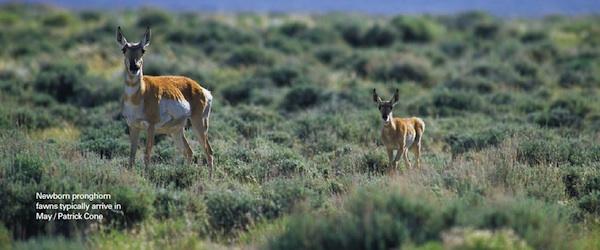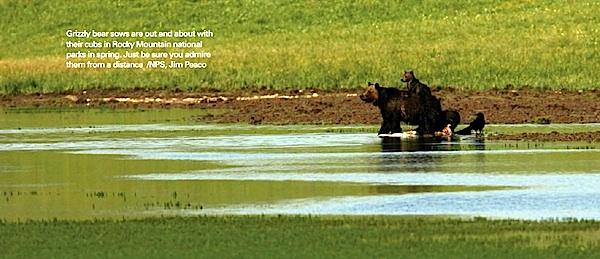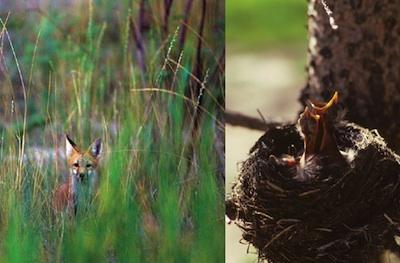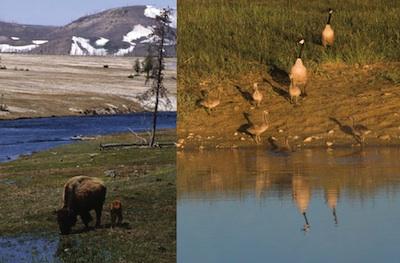
Winter had loosened its icy grip on the high country. Faint stirrings from burrows and dens and caves led the young critters into a new world of running water, budding plants, and warm sunshine. Warm weather and life springs abundant.
Elk calves, still sticky from their birth in late May, nurse from their mothers. Bison nuzzle their young and begin teaching them the ways of their new world. Moose calves stay close to their mothers. And these bear cubs, playing in the sun, would soon learn how to stalk these young animals. After the winter-killed elk and bison carcasses were picked clean in the meadows, they were on the hunt.
In mid- to late-March impatient, and hungry, adult boars leave their dens in search of food, soon followed by female bears without cubs. Later, the mothers would emerge with their young, and you definitely don't want to be too close when they're around. They'll dig up wildflower bulbs, dig up burrowing rodents, and grab the errant elk calf when they can.
The Lamar Valley in northeastern Yellowstone is a spectacle of animals, the Serengeti of America. Large herds of bison flow like molasses across the hills. Roving gangs of wolves patrol for prey. Elk keep a watchful eye as they graze the deep grass. There's always some sort of action.

A few years ago we watched as a male grizzly chased down and caught a young elk calf. Its squeals of terror carried across the valley as its young life was brought to an abrupt end. As we observed the scene, a visitor pleaded with the ranger to stop the carnage. He didn't say a thing but a look said, 'You stop him.' I tonelessly whistled a tune... 'today's the day the teddy bears have their picnic.' It's the natural order of things here, where the animals fight, take flight, or become dinner.
Spring is a great time to be in the park. There are young coyotes stalking baby grouse; wolves chasing down newborn bison; antelope grazing with their twins in the sage flats.
While the road from Mammoth to the Northeast Entrance through the Lamar Valley is open year-round, depending on the winter, others open in April or May. There's drama in every turn. In the Hayden Valley you'll see grizzlies with their faces covered with the gore from bison carcasses, but make sure you keep an eye all around you: one year we were so intent on watching a bear that another had started to come up from behind us. Remember, they're hungry and so are their babies.
Remember, too, if you're hiking to make sure you're in a group of three or more, make some noise on the trail, and keep the bear spray handy, not buried in your pack.

Look carefully, wildlife is everywhere in the parks. Patrick Cone photo.
South of Yellowstone in Grand Teton National Park roadside animal sightings are common too. At the oxbow bend of the Snake River you may see young swans, antelope, fox, porcupines, the occasional young badger, a family of otters, and plenty of moose.
Of course this spring spectacle is not peculiar to Yellowstone and the West. If you can't make it to Yellowstone this spring, perhaps you can watch the coastal grizzlies with their young at Katmai, Lake Clark, or Glacier Bay national parks in Alaska. Or head to Shenandoah in Virginia or Great Smoky in North Carolina/Tennessee to watch the black bears and their brood.
Visit Cape Lookout National Seashore in North Carolina to spot newborn foals of the seashore's Banker horses. You can observe bighorn sheep lambs in Rocky Mountain National Park in Colorado, and young desert bighorns in Zion National Park in Utah. Bison calves graze at both Theodore Roosevelt National Park in North Dakota and Wind Cave National Park just one state south.

Whether it's bison or geese, spring is a time of rebirth in the parks. Patrick Cone photo.
If you're more attuned to the seashore, then visit Cape Hatteras National Seashore (in North Carolina), Canaveral National Seashore (in Florida), Cumberland Island National Seashore (in Georgia), Padre Island National Seashore (in Texas), or Biscayne National Park (in Florida) to perhaps catch green or loggerhead sea turtles laying their eggs, or for the rush to the surf of the hatchlings when they climb out of their sandy incubators. On the other side of the country in Olympic National Park in Washington, the Whale Trail sign at Kalaloch Lodge will show you where to watch for orca and gray whales, as well as sea lions, porpoise, and sea otters. Point Reyes National Seashore down the coast in California is a reliable spot for spotting gray whales and their newborn calves.
Birders, meanwhile, scan the Precipice Cliff area in Acadia National Park in Maine to watch nesting pairs of peregrine falcons. You can even watch the young birds as they stretch their wings in June and take flight.
Spring! It's a time of renewal and rebirth. It's a great time to visit any unit in the National Park System to view young wildlife in a natural environment without the crowds. It'll put a spring in your step as well.



Add comment